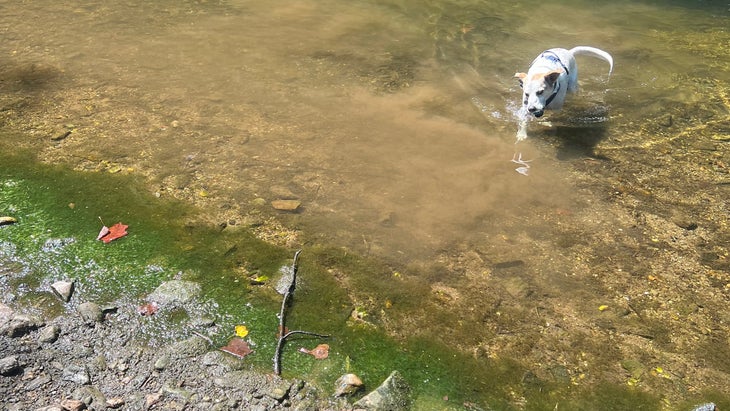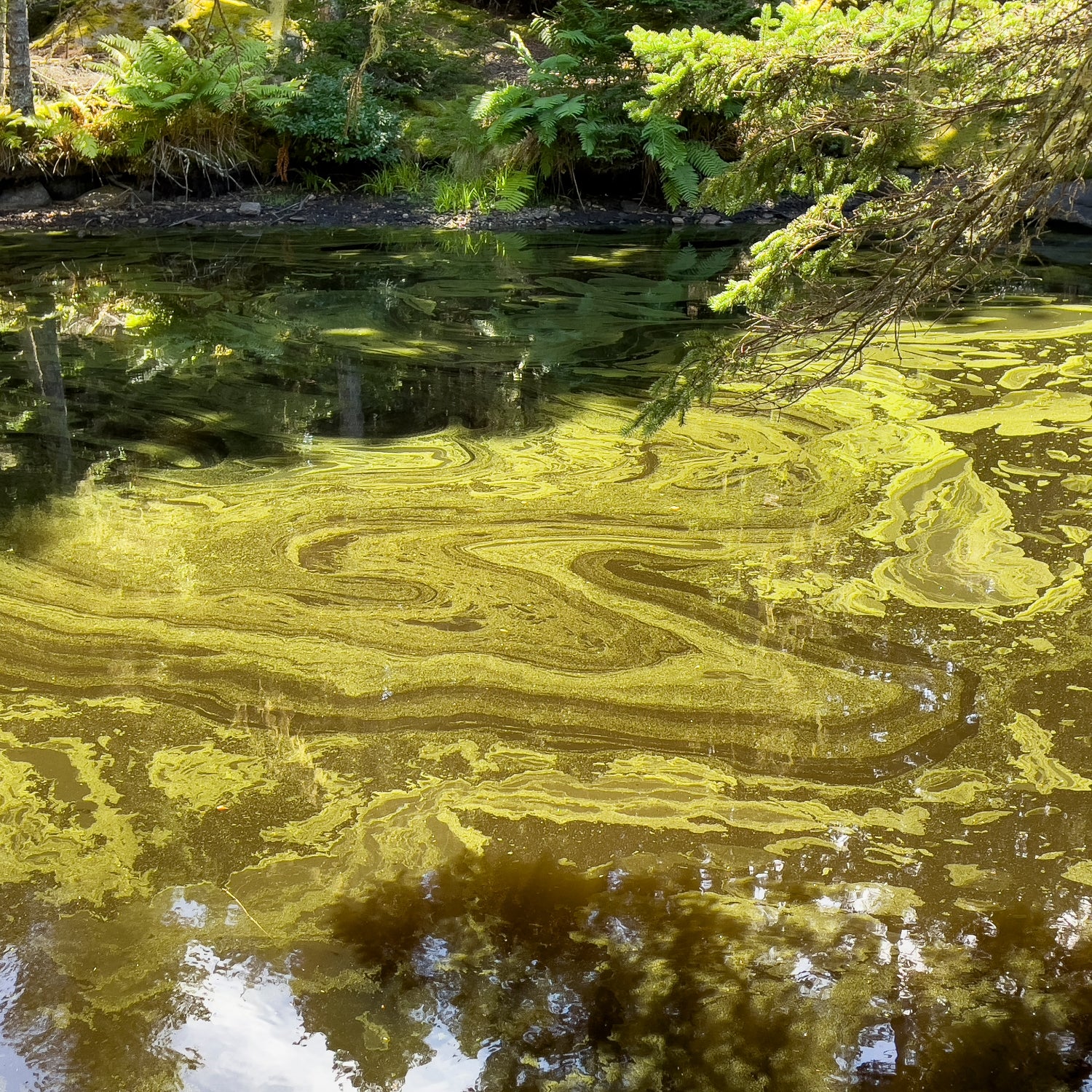The other day, during a particularly brutal heatwave near my home��in Philadelphia, Pennsylvania, I took my dog, Ollie, on a shaded hike that ran alongside a stream. After being cooped up inside for a few days, he desperately needed to burn off some energy—and cool down—so I let him dive in.
In the middle of his dip, I noticed a clump of green algae creeping toward him. I’ve seen about dogs dying after ingesting toxic blue-green algae (and just last month, a woman claimed in a viral ��that her sweet pup, Cora, died after ingesting blue-green algae in Lake Tahoe), so I ushered him out of the water, snapped a photo so he could get properly treated if he got sick, and wrapped up our hike. I was being a total helicopter dog mom, I figured, primarily because I wasn’t exactly sure how to tell the difference between safe and dangerous algae. But I’d much rather err on the side of caution, especially when it comes to Ollie’s health.

It turns out my concern was warranted. (HABs), or the overgrowth of toxin-producing algae, expand like crazy when it’s hot outside. Within the last week, issued a handful of warnings due to dangerous blooms in multiple lakes, and officials in Northern California notified residents about potentially harmful algae in rivers and lakes. Data from the (CDC) shows that blooms–often found in freshwaters like lakes and reservoirs–spike during the summer months (you know, right around now, when people trek to their local watering hole to camp out, cool off, and play fetch if their pup’s in tow). Although blooms might look like a harmless patch of moss, even a tiny bit can make you—or your dog—pretty sick.
What You Need to Know About Algal Blooms
Algae are microscopic organisms that, at normal levels, are an important part of a healthy ecosystem, according to the . But when heavy rains pull nutrients from the land into the water, or when temperatures soar, algae can multiply rapidly and form a blue-green bloom. You might also see red or brown blooms. They’ll create stringy lumps on the banks of rivers, blue scum at the edge of a lake, or green streaks across the ocean.
Some blue-green blooms produce toxins called cyanobacteria that are poisonous to humans and dogs. But not all blooms are dangerous. “Some do not produce toxins and won’t cause any major harm,” says , a Water Resources Extensions Agent at the University of Florida who studies harmful algal blooms.
Algal blooms have been —and dangerous ones are more likely to occur in still water (think: ponds and lakes), according to the . But you don’t need to freak out every time you see a patch of algae—less than one percent of blooms produce toxins, per the .
Of course, many freshwater bodies sprinkled across the U.S. aren’t regularly tested. And it’s impossible to tell if algae is harmful by eyeballing it. Most blooms—even the harmless ones— (Krimsky describes the odor as a musty decay). Even that can release toxins don’t always do so consistently. “That’s what makes it so tricky,” she says. The only way to know for sure that a bloom is harmful is to test it in a laboratory.
Why Algal Blooms Can Make You (or Your Dog) Sick—and How to Protect Yourself
How both humans and dogs react largely depends on the toxin itself and how the exposure happened.
How Harmful Algal Blooms Affect People
Blooms can release all kinds of toxins. As �����ԹϺ��� previously reported, saxitoxin can lead to paralysis, and microcystin can damage the liver if ingested. Swallowing water could lead to diarrhea and abdominal pain. Swimming through green muck could create an itchy rash or cause conjunctivitis (a.k.a. pink eye). Inhaling the toxins at the beach or on a boat could trigger wheezing and coughing.
And if you fish? Well, you might want to think twice before eating your catch; some data from the CDC suggests that scarfing down a toxin-soaked fish could give you a brutal case of the runs. It varies, but symptoms can appear in a matter of minutes or hours later, per the .
How Harmful Algal Blooms Affect Dogs
Dogs (and other animals) can get very sick if they come in contact with toxic algae–even more so than people. They splash around in foam, lick their fur, or swallow water when retrieving a toy and wind up consuming larger doses, says Krimsky. Their symptoms tend to come on fast and include anything from weakness and diarrhea to tremors, difficulty breathing, and seizures, says ��a professor of clinical veterinary toxicology at UC Davis Veterinary Medicine. In general, symptoms worsen with higher doses and prolonged exposure—but even small amounts of certain toxins can cause serious illness, he says.
The best thing to do is steer clear of water that, well, looks weird. “If it’s green or there’s a scum or a smell, use your best judgment and stay away,” says Krimsky. Blooms don’t typically cover the entire surface, so try to avoid the still, murky parts and head toward clear, flowing water (because movement flushes away algae cells).
So, what’s the best way to know if toxic algae are lurking nearby? Keep an eye out for alerts from your local government, and when you’re out and about, look for advisories pitched around the water itself.
It’s also worth checking out the , which tracks algae outbreaks and is updated biweekly. If you’re venturing somewhere remote, , the chief of wilderness and environmental medicine at the University of Colorado Anschutz Medical Campus, recommends contacting local land management agencies to see if there’ve been any recent reports of algae in the region. It’s also a good idea to be cautious around water with a history of dangerous blooms, Krimsky says.
I’ve Been Exposed to a Toxic Algal Bloom. Now What?
If you think you—or your pet—have been exposed, contact or the . Provide as much info as possible, like where you were and what the water looked like, and follow their guidance.
You also want to immediately move away from the questionable water and rinse off with clean water, Dr. Lemery recommends. Most will feel better soon after they get away from the bloom or . “Every case doesn’t need treatment,” says Dr. Lemery, but if your symptoms don’t improve, head to an urgent care clinic or emergency room.
The risk of mortality in humans is very low, but the prognosis in dogs is bleaker, so you’ll want to have them checked out at the first sign of any abnormal behavior. There isn’t a specific antidote for algae ingestion, according to Poppenga and Dr. Lemery, so dogs and humans alike will be treated with supportive care (think: oxygen, fluids, and assisted ventilation).
As for me? Well, I think I’ll stick to the trail next time. I asked Krimsky what she thought about that photo of my pup. She told me he’s very cute (she’s right) and that the algae accumulated on the shore. I said, based on our chat, that it seemed there was no way to know if it was toxic or not—and maybe the smarter choice would have been to let him play in a clearer area. Her response: “Exactly!”


